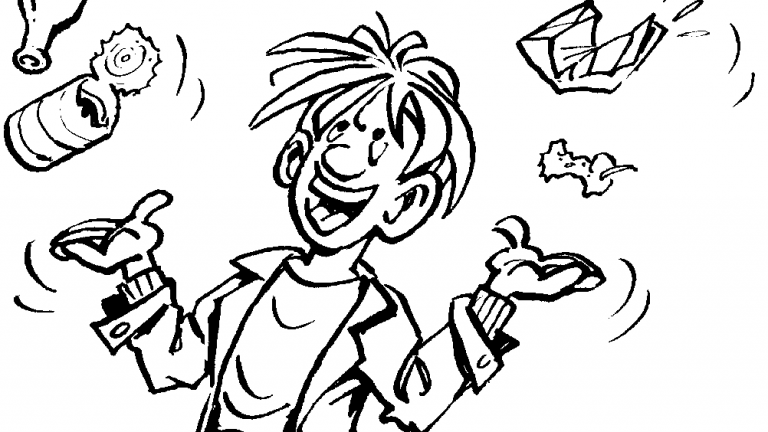Young people need rules, educational guidelines and guidance. However, they also want to help shape their leisure activities.
The development of a "commitment" combines these concerns.
The path has six stages
Young people need rules, educational guidelines and guidance in order to find their way in everyday sports life. However, they also want to help shape their favorite leisure activity. Developing a "commitment" combines both concerns.
While "Commitment" describes a statement or obligation of an individual, "Commitments" describes jointly made intentions and agreements. Within a team, therefore, both forms can be combined.
Leading catalysts
Children and young people like to emulate adults. The coach and the leader therefore have an important role to play. They act as catalysts and have a significant influence on the beliefs and actions of the young athletes entrusted to them. Jugend+Sport places the leader's personality at the center of training and further education and has therefore developed a new teaching document on the topic of "Commitments". They form the basis for the following "six steps to added value in sport".
1. Recognizing basic attitudes
Beliefs, values and views determine our thoughts and guide our actions. A process always begins with an examination of one's own basic attitudes. What is important to you personally? Do you put success above all else and perhaps encourage "lazy tricks"? Or are fairness, consideration and humanity more important to you? You need to become aware of your values and views. The conviction must grow that jointly developed agreements are worthwhile and that they have a positive influence on cooperation in sport. Only in this way can you as a coach or leader have a positive influence on the basic attitudes of young people.
2. Passing on values
Your attitudes influence the adolescents. You must be aware of this responsibility and promote fair sporting values in the training group. Only if you take a clear stance (e.g. "Doping is cheating: on your opponent, on the sport and on yourself") will you appear credible.
3. Feel the pulse
What is on the team's mind? What is on your mind? It is important that you feel where the "shoe pinches". The more concerned the group is, the more willing it is to discuss its thoughts and actions. Use a current situation (see article Commitment - Together) as a starting point. You observe how defeat in a game leads to frustration and aggression in your team and that opponents and spectators are verbally and physically attacked. You derive possible principles of your own from this. These serve as a basis for later group discussions.
4. Joint process
If the agreements are to have a lasting effect, they must be entered into voluntarily and worked out together. After all, those who are allowed to have a say are more likely to keep agreements made together and feel responsible. The group must therefore be able to help shape the process from the outset, including when drafting and formulating the commitments. Reserve enough time for this. Confront the players with your observations: "After the last game, there was swearing, shouting and destruction of equipment. Referee decisions were constantly commented on and everyone on the pitch behaved completely out of line." You then pass on your own values and principles to the team about how you imagine fair behavior on the pitch: "I know that winning is fun and losing is frustrating. But if you want to win, you also have to be able to lose. So you are strong if you remain fair even in defeat." The crucial question now is how the team will deal with victory and defeat in the future. You have small groups work out their own principles on how to deal with defeat without aggression. These principles are compiled and written down. WE forms emphasize the commitment of each individual. The team decides which commitments are binding and gives the whole agreement the title "Fair play - even after the end of the game", which is signed by everyone.
5. Living up to and keeping agreements
The drafting of the agreement is not the end of the story. The commitments must also be put into practice: Posting in the clubhouse, presentation in the club organ, communication to the board and parents. This strengthens the will and commitment to adhere to the agreements made together. Rituals (a chant at the start, a shout from the coach during the game, a song after the match, etc.) can remind the group of the agreement and should be practiced during training. Important: New members must not be forgotten. They must be included in the agreements.
6. Enforce agreements
Breaches of the commitments always occur. A distinction must be made as to whether general rules of the game and laws have been violated or whether the joint agreement has been breached. In the latter case, those at fault must be made aware of their behavior and seek their own "suggestions for redress". Back to our example: You observe how a player, after several weeks of adhering to "fair play - even after the end of the game", gets angry at the referee's performance and kicks away the drinking bottles after the final whistle. You confront him with your observation: "I've noticed that you're struggling to stick to our group rules. How do you explain that?" The primary aim is to clarify the situation. Power struggles and hasty interpretations should be avoided. During the conversation, you must let the offending person know that you care about how they feel and behave. For more serious offenses, in some cases it makes sense to point out specialist agencies that can offer the young person support and to request help from counseling centers. Sanctions against those who do not comply must be proportionate. Fixed sanctions and financial compensation are inappropriate.
Source reference:
Contents: Jugend+Sport, mobile 1, Dec. 2004, COMMITMENTS
Authors: Ralph Hunziker, Hans Ulrich Mutti, Anton Lehmann
copyright: www.mobile-sport.ch
Picture: www.juropa.net
Content may be automatically translated. Help improve the quality of the translation with your editing!


